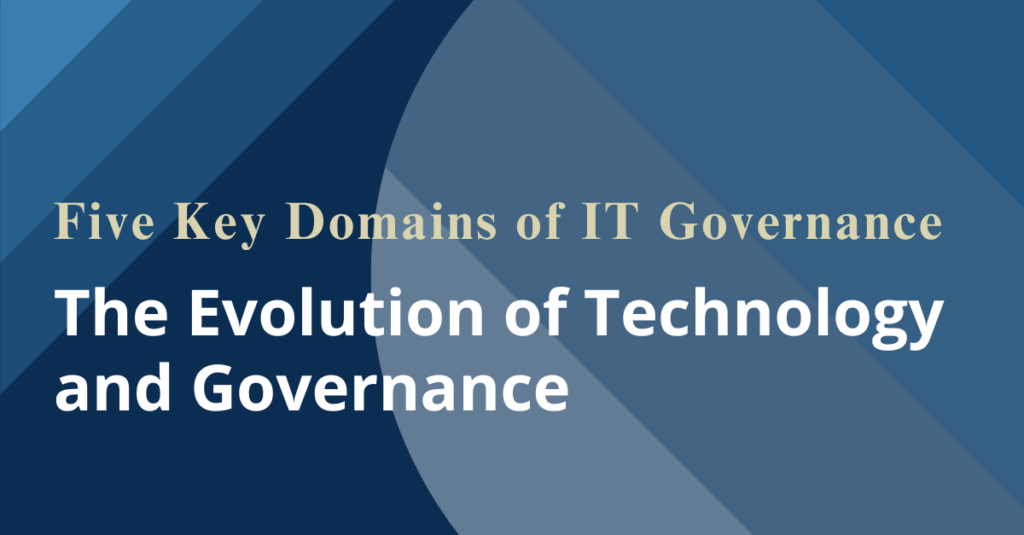March 29, 2024
The Evolution of Technology and Governance
A company’s ability to harness technology solutions and use it to enhance strategic initiatives can result in a competitive advantage. Through this lens, many business leaders view technology as a strategic investment, rather than a cost. You will learn about the five key domains of information technology (IT) governance and how companies are leveraging technology to meet strategic objectives.
Drivers of Technology Change
Two major events in recent history served as a catalyst for technology change: the COVID pandemic and generative artificial intelligence (AI). These events accelerated the technology adoption curve exponentially. The large-scale adoption of new technology has generated more board member attention to the IT infrastructure, and has created greater exposure to cybersecurity and business continuity risks. Boards must proactively increase the amount of technology acumen in their ranks in order to enhance the organization’s digital resiliency. The essence of digital resilience is being able to adapt and recover from a cyber attack or service interruption.
Emerging cybersecurity risks have also caught the attention of auditors and regulators. Regulators want to see systems integrated with one another and internal controls in place over company data. They want to understand the key monitoring capabilities that are in place to prevent and detect technology issues timely. The NAIC Insurance Data Security Model Law (#668) was adopted in 2017, but states have been slow to adopt it, with only 23 adoptions to date.
5 Key Domains of IT Governance
The governing body should prioritize IT initiatives in order to build in digital resilience. For example, companies that embraced a remote working environment and hybrid tools before 2020 experienced higher levels of success and less business interruption than companies that did not have those in place prior to the pandemic.
The five domains of strong IT governance include:
- Strategic alignment: Is the IT strategy aligned with the corporate strategy?
- Value delivery: How is success evaluated? For example: SWOT analysis, return on investment (ROI), benchmarking
- Risk management: What are the IT risks and the company’s response to identified risks?
- Resource management: Are the right people in the right roles to move IT initiatives forward?
- Performance management: Are the right IT policies and procedures in place for accountability?
Strategic alignment among the business unit decision makers is key to the success of any IT initiative. Anticipate the need for IT skills on the management team and the governance team. Leaders should consider the skills the company needs today, tomorrow, and five years from now to stay relevant.
Benefits of Leveraging Emerging Technologies
Technology doesn’t have to be an afterthought. Emerging technologies are intended to make our lives easier. Users can spend more time on data analysis rather than data preparation. Technology can enhance the company’s ability to make timely decisions based on the data.
Real time data for reporting purposes improves management and monitoring of expected and unexpected changes and it improves the accuracy of models that predict future trends. The data is more accurate and more timely leading to efficiencies and increased productivity.
AI presents the most opportunity in all aspects of a company. Insurance companies deal with a high volume of data and automation has matured to a state where the process from underwriting all the way to issuing a quote is automated. Another area that presents an opportunity for insurance companies is predictive analytics, for risk management for both claim handlers and underwriters.
IT Governance Best Practices
There are four essential elements of IT Governance:
- Inclusion of governance members with technology skills – Diverse perspectives on the Board
- Separate IT Steering Committee – Provides accountability for strategic initiatives
- Frequent Interaction – IT management and the Board have open lines of communication
- Periodic review of key IT policies and procedures – To ensure there is buy-in for large technology initiatives
The company’s IT risk assessment drives both accountability and adaptability. Companies should have the ability to pivot quickly when something happens and to prevent and detect issues before they occur. The IT risk assessment should be part of the frequent interaction between IT management and the Board noted above.
Conclusion
The ability to view technology through a forward thinking lens provides value to stakeholders in ways such as improving the user experience by creating an efficient and streamlined process. Thinking about how users interact with the organization via systems and processes can be a way to attract additional business or it can be a deterrent to further business, based on how the technology (product) interacts with the user.
To learn more, listen to Johnson Lambert’s Andrew Cleveland and Bobby Waszak discuss the evolving role of technology in today’s boardroom with Ted Tzeng, Chief Information Officer at COPIC in our recent Governance Series webinar.
Contact the Johnson Lambert Business Advisory Services team today for your cybersecurity needs.



